I’m an on and off fisherman, mainly fly fishing; I worked in a few fly fishing shops in my youth (gasp, I’m not THAT old, should I say “youth”?). Also, recently I installed Flick Fishing for the iPhone and have spent numerous hours on my commute trying to hook fish. Well, that go me thinking. Since part of my job as a Technology Evangelist is to grow my social network so that I can do my job even better and reach even more people, I spend a couple of hours a day (in fragments) working with Twitter. (For those of you who don’t know what Twitter is, watch this video as it explains it well.)
As I try to communicate about various technological items from software to hardware to other services, I find that sometimes people understand things better through analogies. So here is one to ponder: Using Twitter is like Fishing. Here are some ideas why I think this is:
- Size matters
- You have to choose the right “gear”
- Lures & Baits
- Catch & Release
- It’s a challenge and a sport
- It’s a social yet individual activity
- “Casting” is an art
- Landing the “big fish”
- Practice makes perfect
- Navigating the waters
- Ponds, streams, lakes, oceans
Let’s go into this a bit more, shall we say, go into deeper waters.
Size Matters – with Twitter, there are always people who are jockeying to get to the top and catch the most fish (have the largest Twitter follower count). Some of the big fish out there are Barack Obama (146,500 followers), Kevin Rose (78,000) and Leo Laporte (66,000). These “fishermen” have really forged their way to the top using a variety of techniques in order to land the most “fish.” Some have simply thrown dynamite into the water (Obama & Kevin Rose) because of their high visibility, while others like Leo Laporte have used skill and dexterity through quality posts and content to catch their followers. The more fish caught (followers you have), the better you are equipped and experienced to do some of the other items on this list.
Choosing the Right Gear – as with fishing, the hardware or gear that you use is critical. When Twitter first emerged, it was primarily web and SMS based. This can be likened to string on a pole, basic yet functional. Now there are hundreds of tools that you can use to improve your skill, or even take some of the skill away from it, making you a bit lazy. Twitter is web-based but they provide an API (essentially a way for 3rd party developers to access the Twitter functionality and data programmatically). This has allowed for some new tools to emerge. Some of the ones that I use are Twhirl and TweetDeck. These help you manage the Tweets that come in more effectively. It’s like moving from a fiberglass rod to a graphite one. You can still fish, but the experience is a bit different and you are potentially more effective. There are also 3rd party Twitter applications (e.g., Twitter Grader or Mr. Tweet) that provide analysis of your data and can give you feedback on things like people you may want to follow, the types of people following you, etc. Think of these services as fishing guides. They can do some of the work for you, but in the end, you have to make the decision on how to play the fish and do the reeling and landing.
“Lures” & “Baits” – The whole thing about fishing is about getting the attention of the fish for one reason or another and having them go after your bait. But obviously fish come in different species with different habits. A Steelhead, for example, is very territorial and tends to strike at flashy things that invade their space. The fly that you would use to catch a Steelhead is one with lots of glitter, foil or flash on it. Other bait imitates life (plastic worms or spinners that flash like tiny fish swimming). And some bait is actual food. When you Tweet something out, you are essentially casting your bait out into the water, hoping for a bite. The better the tweet, the more likely you will get a bite (a reply from someone) or a hooked fish (a new follower). Of course, depending on how you tailor your tweet and the content, you will catch (or lose) some of your followers. How you lure people into your conversation takes practice. If you are fishing for “steelhead,” craft your message directly at someone and challenge them. If you are just throwing out worms and a bobber, be prepared for anything.
Catch & Release – Twitter conversations tend to be short and quick (140 characters or less). You tweet something out, someone replies, you reply back…this cycle may happen a few times more, but then it ends. I liken this to the practice of Catch & Release fishing, the idea being that you hook a fish, play it a bit and lose it, or possibly land it and then set it free. The longer you have a sustained conversation, the more like you are to attract the attention of other fish. If you get stuck in a conversation too long, you may scare those fish away. It’s a careful balance.
Challenge & a Sport – I like to fish because it is challenging, you get out in nature, and the more you practice, the better you get. Also, as you get better, you try to find harder and harder places to fish. For me, Twittering is very similar (except I don’t really get out in nature that much…sometimes I Tweet when walking down the street…but that can be dangerous, I almost walked into a pole a few times). It’s fun to cast your line (literal or written) out to the unknown and see what happens. You may land a small fish (someone with a tiny amount of followers) or a real lunker (those with huge followings). There is a definite feeling of satisfaction when you hook and land a fish or a new follower. It makes you go back for more.
Social Yet Individual – When you go out on a fishing trip, you typically go with a bunch of buddies. And, usually when you are out, you encounter other fishing parties of similar groups. You might consider this to be your core set Twitter followers, the ones that you frequently tweet with. Fishing, like Twitter, can be very social, but it is also very individual. Fly fishing is a good example. A group of people may head out on a trip together, but once they hit the river, they spread out and work the river on their own. While you might be Twittering with your core group, your goal is also to land new fish so you need to work on your own individual personality and talk about things that make you unique.
Casting is an Art Form – When you are just learning how to fish, chances are that you will scare some fish away with some bad casting. Casting (especially with fly fishing) takes a lot of careful practice before you even start to become slightly good at it. But eventually, with time, you do get better. While before I mentioned that what you write about is a “lure” to entice people in, how you craft your 140 character message is important as well. Most people, when they first start Twittering, post extremely silly things like “Just getting on Twitter.” I liken this to the new fisherperson who is just learning how to cast. Eventually, they get better and begin to perfect the art of crafting an engaging tweet. I know one Twitterer, Stowe Boyd, who tells you how to “cast” to him. He and some others developed the idea of a Twitter Pitch or TwitPitch, used specifically when pitching a product or company to a reporter. In this case, your cast and lure are almost pre-determined for you, you just have to make your presentation perfect.
“Landing the Fish” – I have already talked about this but it warrants some more information. In the iPhone game, Flick Fishing, there are two challenge games: one for the most amount of fish and one for catching the largest fish. Using Twitter is no different. In order to effectively get your message out to as many people as possible, you need to have as large of a following as possible. Similarly, you always want to try to land a “big fish,” someone like a Robert Scoble who, if you are pitching products or technology and who has a huge following, can get your message out to even more people, in turn helping YOU land more fish. In order to help you land your fish, you must have engaging content (see “lure” and “casting” above).
Practice Makes Perfect – The more you practice doing one thing, you will most likely get better at it. This is true with fishing as well as twittering. One thing to remember, however, is that you CAN learn bad habits and it is difficult to unlearn them. If you do acquire a habit that you want to lose, work on breaking it. Or if a more “senior” fisherperson or Twitterer gives you some advise, listen to it. The worst thing that can happen is snapping your line (having your Twitter followers “unfollow” you). Luckily, unlearning a bad twitter habit should be a bit easier that trying to undo some bad fly casting that you have gotten into your muscle memory. I recommend against using profanity in Twitter, for example, as you may offend people. Provide information that is relevant, interesting, helpful, informative, and even funny. Be willing to try new things when you tweet. It’s tips like these that you get from the “Papa Hemmingways” out there that can really help you improve your skills. On a side note, I think Hemmingway would have been a fantastic Twitterer.
Navigating the Waters – Your twitter universe (twitterverse) is potentially vast. Think of it as a complete body of water. When you attack a stream, for example, you get to know certain areas of it better than others. There are deep pools or undercut banks where you know all of the big fish hang out, and you avoid the shallow, hot waters. When you start tweeting as a newbie, you are basically fishing in a pond. It’s not big and not challenging. You may have set it up with a few of your friends. Once you get your lures and casts figured out, you move away from your pond and maybe to a lake where you will attract new larger fish and improve your expertise. The more comfortable you get with your skill and your toolset, the larger the waters you will fish, and the bigger the “fish” you will land.
Ponds, Streams, Lakes, Rivers, Oceans – Each body of water is different and presents a different fishing experience, challenge and result. While in the previous item, I talked about how you can move from a small (easier) pond up to a lake (which is more difficult) and eventually out to the huge (difficult) ocean, another way to use the water analogies is to compare the various bodies of water to the other different types of Social Conversation and Networking platforms out there are (e.g., Plurk, Identi.ca, Pownce – no longer, Tumblr, Jaiku, FaceBook, MySpace, etc.). If you stay in one particular body of water, you are more likely to become an expert there. If you move from stream to pond to ocean, you become more of a generalist. It will take you longer to become an expert, but you have a wider range of experience.
Note: Twitter even has it’s own version of fishing. The above image is called the “Fail Whale” which you see when Twitter is having some issues.
I hope that you have enjoyed this little voyage down the river of Twitter. If you fish, I think that you can see many of the similarity between using Twitter and casting a fly, lure or bait out on a body of water. There is a trill when you get a bite and an even bigger thrill when you land a fish. With actual fishing, I am now at the point were I don’t even need to catch anything and still have a wonderful time (enjoying nature, friends and just being away from it all). I feel I am almost the same way using Twitter now. I enjoy it and it is becoming less important to me to catch as many fish as possible. I’m now looking more for the large fish and having some fun in the process.
Oh, and if you want to join my “fishing party”, follow me at http://www.twitter.com/hightechdad .
HTD says: Hope to see you out on the water!
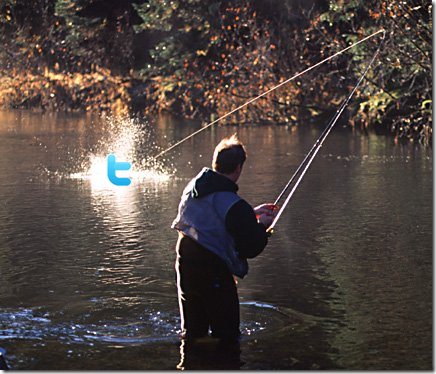
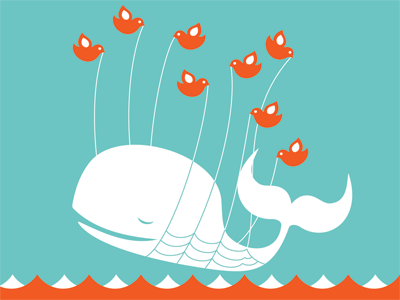
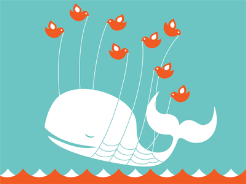
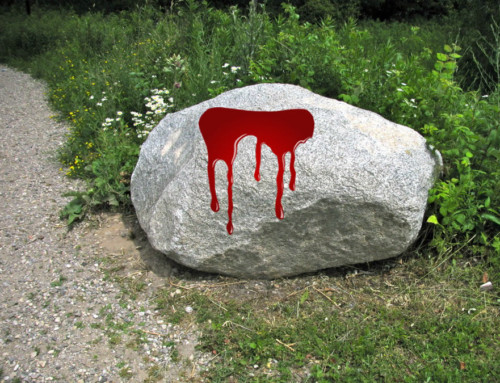
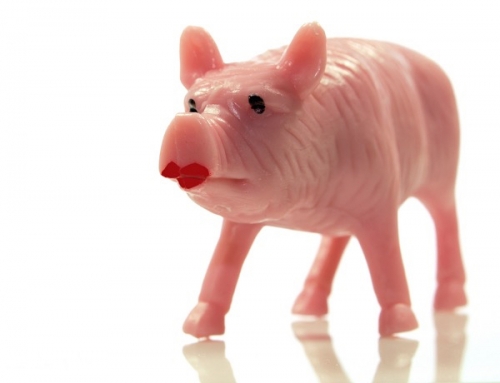


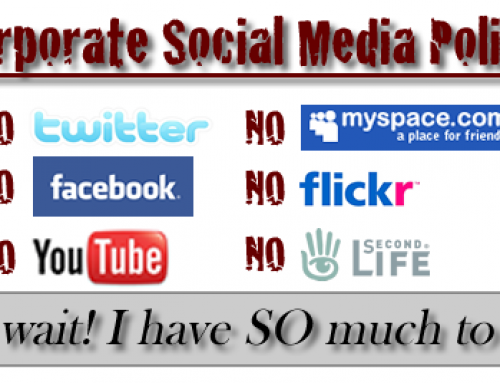
Leave A Comment